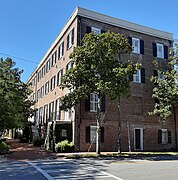
Frederick William Vanderbilt was a member of the American Vanderbilt family. He was a director of the New York Central Railroad for 61 years, and also a director of the Pittsburgh and Lake Erie Railroad and of the Chicago and North Western Railroad.

Restalrig is a small residential suburb of Edinburgh, Scotland. It is located east of the city centre, west of Craigentinny and to the east of Lochend, both of which it overlaps. Restalrig Road is the main route through the area, running from London Road, at Jock's Lodge, to Leith Links. It is in the ward of Lochend.

The Belair Mansion, located in the historic Collington area and in Bowie, Maryland, United States, built c. 1745, is the Georgian style plantation house of Provincial Governor of Maryland, Samuel Ogle. Later home to another Maryland governor, the mansion is listed on the National Register of Historic Places.

Annandale Plantation was a cotton plantation worked by enslaved laborers in what is now the Mannsdale neighborhood of Madison, Mississippi.
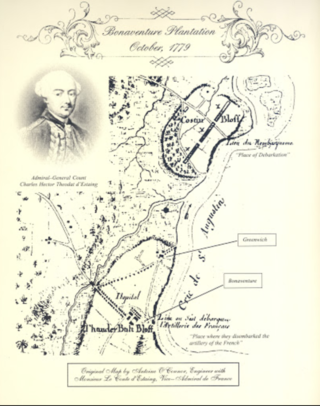
Bonaventure Plantation was a plantation founded in colonial Savannah, Province of Georgia, on land now occupied by Greenwich and Bonaventure cemeteries. The site was 600 acres (2.4 km2), including a plantation house and private cemetery, located on the Wilmington River, about 3.5 miles east of the Savannah colony.
The Marshall House is a historic building in Savannah, Georgia, United States. It was opened in 1852 by Mary Magdalene Marshall as one of Savannah's first hotels, built thirty years after the City Hotel, the city's first. Located on East Broughton Street, it is the city's oldest operating hotel today, owned by Savannah's HLC Hotels, Inc., which also owns the city's Olde Harbour Inn, the Eliza Thompson House, the East Bay Inn, the Gastonian and the Kehoe House. The building was occupied by the Union Army in 1864 and 1865 during the American Civil War.

Bull Street is a major street in Savannah, Georgia, United States. Named for Colonel William Bull (1683–1755), it runs from Bay Street in the north to Derenne Avenue in the south. It is around 3.40 miles in length, not including the section interrupted by Forsyth Park. It is the center of a National Historic Landmark District.
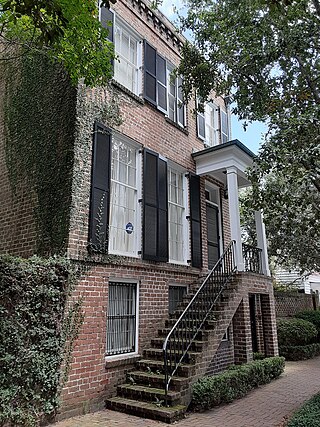
The Margaret Pendergast House is a home in Savannah, Georgia, United States. It is located in the northeastern civic block of Warren Square, and was built by 1868. It is part of the Savannah Historic District, and was built for Margaret Pendergast. The home is a three-storey brick structure.

The Wetter House was a residence in Savannah, Georgia, United States. Originally built in 1822, it was expanded and remodeled in 1857 for Augustus Wetter, a Savannah architect and businessman. Its demolition in 1950 was an impetus for the formation of the Historic Savannah Foundation in 1955.

Abercorn Street is a prominent street in Savannah, Georgia, United States. Located between Drayton Street to the west and Lincoln Street to the east, it runs for about 7.8 miles (12.6 km) from East Bay Street in the north to Harry S. Truman Parkway in the south. It is concurrent with SR 204 from 37th Street south. The street is named for James Hamilton, 6th Earl of Abercorn, a financial benefactor of the Georgia colony. Its northern section passes through the Savannah Historic District, a National Historic Landmark District.
James Johnston Waring was a 19th-century American physician. His grandson was academic Joseph Frederick Waring.

Abigail Minis was a businesswoman and landowner, prominent in Savannah, Province of Georgia, during the American Revolutionary War. She was a European immigrant, along with her husband, Abraham Minis, to the newly settled colony of Savannah, in 1733. Despite their not knowing if they would be received, General James Oglethorpe, founder of the colony, allowed Minis and her family entry and granted them land.
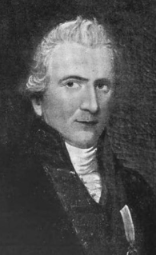
John Berrien was a brigade major during the American Revolutionary War.
Ann Fox Drayton was an American landowner, prominent in the American South during the early 18th century. Along with her relatives Rebecca and Charlotte, she became known as one of the women of Drayton Hall, which her youngest son, John (1716–1779), built. Drayton Street in Savannah, Georgia, is named for her.

Broughton Street is a prominent street in Savannah, Georgia, United States. Located between Congress Street to the north and State Street to the south, it runs for about 0.75 miles (1.21 km) from Martin Luther King Jr. Boulevard in the west to East Broad Street in the east. Originally known only as Broughton Street singular, its addresses are now split between "West Broughton Street" and "East Broughton Street", the transition occurring at Bull Street in the center of the downtown area. Broughton Street is named for Thomas Broughton, lieutenant-governor of South Carolina.
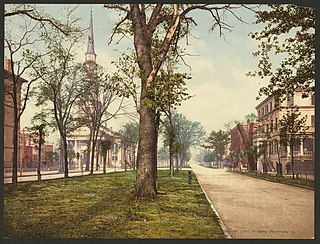
Oglethorpe Avenue is a prominent street in Savannah, Georgia, United States. Located, in its downtown section, between York Street to the north and Hull Street to the south, it runs for about 1.26 miles (2.03 km) from the Atlantic Coastal Highway in the west to Randolph Street in the east. It was originally known as South Broad Street, then Market Street. After being named South Broad Street again for a period, it became known as Oglethorpe Avenue in 1897. It was formerly Oglethorpe Avenue singular, but its addresses are now split between "West Oglethorpe Avenue" and "East Oglethorpe Avenue", the transition occurring at Bull Street in the center of the downtown area. The street is named for the founder of the Savannah colony, James Edward Oglethorpe.

John Eppinger was a German master builder who was prominent in the 18th century. After arriving in Savannah, Province of Georgia, he became an American Revolutionary War patriot and served in the conflict. Patriotic meetings were held in his home, then known as the Eppinger Tavern. The building is still standing, believed to be the oldest intact brick structure in Georgia.
John Derst was a German businessman based in Savannah, Georgia, United States. A prominent baker, his product, Captain John Derst's Good Old-Fashioned Bread, is still produced by Savannah's Derst Baking Company, which he founded in 1867. He was also a city alderman for four years.

Noble Andrew Hardee was an American businessman based in Savannah, Georgia, where he was a cotton factor and owner of N. A. Hardee Company. In 1860 he had constructed today's Noble Hardee Mansion in the southwestern corner of Savannah's Monterey Square.

Mary Marshall Row is a historic row house in Savannah, Georgia, United States. It stands at 230–244 East Oglethorpe Avenue, overlooking Colonial Park Cemetery from the north. They are contributing properties of the Savannah Historic District, itself on the National Register of Historic Places.


